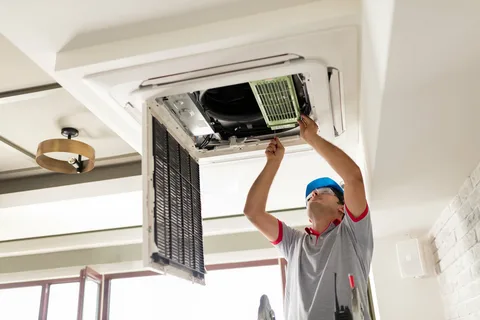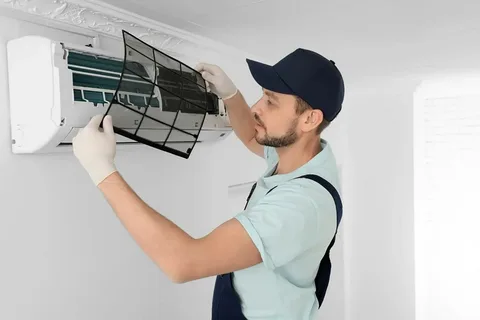The hot air exchanger has emerged as a leading solution in the quest for optimal home comfort and energy efficiency. This innovative system regulates indoor temperatures and significantly reduces energy consumption, making it an ideal choice for environmentally conscious homeowners. In this blog post, we delve into the mechanics, benefits, and applications of air-to-air heat-exchangers in residential settings, helping you make informed decisions for your home.
The Basics of Hot Air-Exchangers and Their Functionality
Hot air-exchangers operate on the principle of heat recovery, capturing warmth from outgoing stale air and transferring it to incoming fresh air. This system ensures the pre-heating of fresh air while maintaining excellent indoor air quality by providing a constant supply of fresh air.
The device comprises a core where the heat exchange occurs, facilitating a comfortable and healthy living environment. These systems are particularly effective during colder months, reducing the reliance on traditional heating methods and promoting energy efficiency. By doing so, they not only create a more pleasant indoor atmosphere but also significantly reduce heating costs.
The separation of airflows ensures that only heat, and not contaminants, is transferred, resulting in a consistent flow of warm, fresh air indoors. This feature is crucial for maintaining a healthy living environment, especially in homes with high energy efficiency standards.
Air Heat Exchanger: Efficiency and Environmental Benefits
Air heat-exchangers are vital in promoting energy efficiency and offering significant environmental benefits for residential spaces. These systems are designed to transfer heat between incoming and outgoing air, effectively regulating indoor temperatures while minimising energy consumption. By capturing heat from stale indoor air and using it to warm fresh outdoor air, air heat-exchangers reduce the workload on heating and cooling systems. This results in lower energy bills and a smaller carbon footprint, contributing to a more sustainable home.
The efficiency of an air heat exchanger lies in its ability to maintain a consistent indoor climate. It ensures that homes remain comfortable year-round, regardless of external weather conditions, by balancing fresh air intake with optimal temperature control. This enhances comfort and promotes better indoor air quality by continuously circulating fresh air, which helps reduce allergens and pollutants.
Environmentally, the use of air heat-exchangers aligns with the growing demand for energy-efficient solutions. By decreasing reliance on traditional heating and cooling methods, these systems help reduce greenhouse gas emissions and reliance on fossil fuels. Furthermore, as energy costs continue to rise, the long-term savings associated with air heat-exchangers make them an economically sensible choice.
Energy Savings with Air-To-Air Heat-Exchangers
Air-to-air heat-exchangers are an efficient solution for enhancing energy savings in residential settings. These systems significantly reduce the energy required for heating and cooling by facilitating heat transfer between incoming and outgoing air.
During colder months, the heat-exchanger captures warmth from the expelled stale indoor air, transferring it to the fresh, chilly air entering the home. This process means that less energy is needed to warm the incoming air, leading to lower heating costs. Conversely, in warmer months, the system can help cool incoming air by expelling heat from the indoors, thus reducing the load on air conditioning units.
Furthermore, by improving overall indoor air quality through continuous ventilation, these heat-exchangers create a healthier living environment while ensuring efficient temperature control. The integration of a heat-exchanger with existing HVAC systems optimises their performance, allowing homeowners to maximise energy savings without compromising comfort. Regular maintenance of the system also contributes to its efficiency, ensuring it operates effectively over time.
The Mechanics of an Air To Air Heat Exchanger
An air-to-air heat-exchanger operates on a fundamental principle of heat transfer, enabling efficient energy use within residential and commercial buildings. The system consists of two separate air streams—one carrying warm, stale indoor air and the other bringing cool, fresh outdoor air. As these air streams pass through the heat-exchanger, heat from the outgoing air is transferred to the incoming air without the two streams mixing.
This process effectively warms the fresh air entering the space, reducing the need for additional heating during colder months. Conversely, during warmer months, the system can also help cool incoming air by transferring heat away from it. This dual functionality enhances overall energy efficiency, minimising the workload on heating and cooling systems.
The air to air heat exchanger typically features a series of tubes or plates designed to maximise surface area for effective heat transfer. Additionally, many modern systems incorporate filters to improve indoor air quality by trapping dust, allergens, and pollutants. Maintenance is crucial for optimal performance, ensuring that filters are cleaned or replaced regularly and that the unit is inspected annually.
Applications of a Residential Air To Air Heat Exchanger
A residential air-to-air heat-exchanger offers versatile applications that enhance home comfort and energy efficiency. Here are key uses:
Improving Indoor Air Quality
The residential air to air heat exchanger continuously circulates air, ensuring that stale indoor air is replaced with fresh outdoor air. This process reduces allergens, pollutants, and odours, promoting a healthier living environment.
 Energy Recovery
Energy Recovery
One of the primary functions of a residential air-to-air heat-exchanger is its ability to recover heat from outgoing air. Transferring this heat to incoming fresh air minimises the energy required for heating and cooling, leading to significant energy savings.
Balanced Temperature Control
These systems help maintain consistent indoor temperatures by efficiently managing heat transfer. A residential air to air heat-exchanger ensures that living spaces remain comfortable year-round, regardless of outdoor weather conditions.
Moisture Control
By regulating humidity levels, a residential air to air heat-exchanger prevents excessive moisture buildup, which can lead to mold and mildew growth. This is particularly beneficial in areas with high humidity, ensuring a dry and comfortable indoor atmosphere.
Integration with HVAC Systems
A residential air to air heat-exchanger can be integrated into existing HVAC systems, enhancing efficiency. This integration allows homeowners to optimise their heating and cooling solutions, achieving better overall performance.
Innovations in Air-To-Air Heat-Exchanger Technology
Innovations in air-to-air heat-exchanger technology are revolutionising energy efficiency and indoor air quality in residential and commercial settings. One significant advancement is the development of high-efficiency heat-exchanger cores, which maximise heat transfer while minimising energy loss. These advanced materials allow for more effective temperature regulation, significantly reducing the energy required for heating and cooling.
Another notable innovation is the integration of smart technology into heat-exchangers. Modern systems can now be equipped with sensors and smart controls that monitor indoor and outdoor conditions in real time. This capability allows for automatic adjustments to optimise performance based on fluctuating temperatures and humidity levels, leading to enhanced energy savings and comfort. Manufacturers are focusing on compact designs, making heat exchangers more versatile and easier to install in various home configurations.
These smaller units do not compromise on performance, allowing for efficient operation in tight spaces. Furthermore, the introduction of dual-function systems that combine ventilation with air purification is gaining popularity. These systems not only exchange air but also filter out pollutants and allergens, significantly improving indoor air quality. Increased emphasis on sustainability has led to using eco-friendly materials and manufacturing processes in heat-exchanger production.
Choosing the Right Air To Air Heat Exchanger Residential
When selecting an air to air heat exchanger residential, several factors warrant consideration to ensure optimal performance and comfort. Evaluate the system’s efficiency rating to determine its potential for energy savings and reduced utility costs. Compatibility with existing HVAC systems is crucial, as seamless integration can enhance overall efficiency and simplify installation. Assess your home’s specific heating and cooling needs to choose a model that provides adequate capacity.
Noise levels are another critical factor, especially if the system will be installed near living areas. Ease of installation and maintenance should also influence your decision, as these factors can affect long-term usability and convenience. Consulting a professional installer can provide valuable insights into the best options for your home, ensuring you select a system that meets your specific requirements.
Additionally, consider the long-term costs associated with the system, including maintenance and potential repairs. Investing in a higher-quality unit may incur higher upfront costs but can result in more significant energy savings and fewer maintenance issues over time.
Maintenance and Troubleshooting Of Heat Exchanger Air To Air Systems
Proper maintenance is crucial for ensuring that your heat exchanger air to air system operates efficiently and has a long lifespan. Regularly scheduled inspections and cleanings are essential, focusing on filter replacement and checking for any obstructions in the airflow. Inspect the core and other components for signs of wear or damage. Make sure that all controls and settings are correctly configured to optimise performance.
Addressing minor issues promptly can prevent more severe malfunctions and costly repairs. For troubleshooting, start by ensuring there are no blockages in the ducts and that the system is free from debris. Check that the fans and motors are functioning correctly and lubricated if necessary.
Consulting a professional for more complex issues or annual inspections can provide additional assurance, helping to maintain optimal indoor air quality and energy efficiency. Regular maintenance will enhance the system’s performance and contribute to a more comfortable and sustainable home environment. By prioritising maintenance, homeowners can extend the lifespan of their heat-exchanger systems, maximising their investment and ensuring ongoing comfort and efficiency.
Conclusion
In conclusion, a hot air-exchanger is a valuable addition for homeowners seeking to improve indoor comfort while enhancing energy efficiency. These systems ensure a consistent and pleasant environment year-round by effectively managing air circulation and temperature. Their ability to reduce energy costs while providing optimal airflow makes them ideal for modern living. As the demand for sustainable solutions grows, embracing this technology can lead to a more comfortable and eco-friendly home experience.
FAQs
What is a hot air-exchanger?
A hot air-exchanger is a mechanical ventilation system that transfers heat between incoming and outgoing air. This device helps maintain indoor temperature by reducing the need for additional heating or cooling, making homes more energy-efficient.
How does a hot air exchanger work?
The hot air exchanger draws in fresh outdoor air while expelling stale indoor air. As the two air streams pass through the exchanger, heat from the outgoing air warms the incoming air, optimising energy use and improving overall comfort.
What are the benefits of installing a hot air-exchanger?
Installing a hot air-exchanger offers several benefits, including enhanced indoor air quality, reduced energy costs, and consistent temperature regulation. It also minimises drafts and creates a healthier living environment by effectively circulating fresh air.
Can a hot air-exchanger be installed in any home?
A hot air-exchanger can be installed in various home types, including new constructions and existing residences. However, consulting a professional is essential to ensure proper sizing and compatibility with the home’s existing ventilation system.
How often should I maintain my hot air-exchanger?
Regular maintenance of a hot air-exchanger is crucial for optimal performance. To ensure the system operates efficiently, homeowners should clean or replace filters every three months and schedule professional inspections at least once a year.
| Other Good Articles to Read |
| Blogs-Peoples |
| Bryan Smith Blogs |
| intellect blogs |
| the fault in our blogs |
| blogs eu |
| oz forums |
| recruitment blogs |
| zet blogs |
| id blogs |
| Blog Studio legale |
| blogs map |
| Related Business Listings |
| Contact Directory |
| Local Business Profiles |

